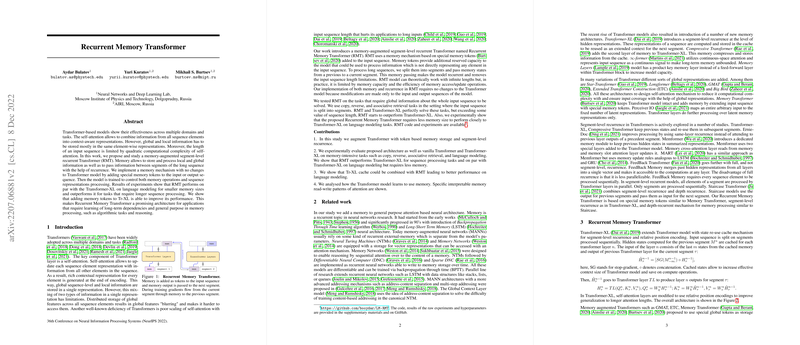Analysis of "Recurrent Memory Transformer"
The "Recurrent Memory Transformer" (RMT) paper introduces a novel approach to enhancing the efficacy of Transformer architectures through memory augmentation, aimed at addressing the challenges of long-sequence processing. The paper builds upon the limitations of traditional Transformers, particularly with respect to their quadratic computational complexity and the inherent difficulty in managing both global and local contexts within a single sequence representation.
Key Contributions
- Memory Augmentation with Tokens: The RMT model enhances the Transformer architecture by integrating memory tokens that allow for the separation and processing of local and global information. This design choice enables a more efficient handling of long sequences through segment-level recurrence.
- Experimental Evaluation: The paper presents an extensive experimental analysis comparing RMT with existing models such as Transformer-XL, especially on tasks that necessitate a comprehension of long-term dependencies. The evaluation spans algorithmic tasks including copy, reverse, associative retrieval, and standard LLMing tasks on datasets such as WikiText-103 and enwik8.
- Improved Performance: Empirical results demonstrate that RMT matches Transformer-XL in LLMing tasks for smaller memory configurations and significantly outperforms it in tasks demanding extensive sequence processing. This demonstrates the RMT model's capability to utilize memory more efficiently, suggesting a potential reduction in required computational resources.
- Combination with Transformer-XL: The paper also investigates the combination of RMT with Transformer-XL's caching mechanism, which results in enhanced performance metrics. This hybrid approach leverages both short-term caching and long-term memory processing, indicating versatility in managing diverse sequence lengths.
Implications and Theoretical Insights
The introduction of memory tokens within Transformer architectures presents a significant design innovation that can potentially streamline memory management in neural networks. The segregation of memory operations through dedicated tokens allows RMT to process input sequences without architectural changes to the underlying Transformer layers, thus maintaining compatibility with existing models.
Theoretically, this approach provides a more granular control over information flow, allowing for not only better memory utilization but also a more refined gradient flow during training via BPTT (Backpropagation Through Time). This aspect could propel further research into optimizing Transformer variants for tasks necessitating complex reasoning and understanding of dependencies over prolonged sequences.
Future Directions
Future research could focus on several avenues:
- Scalability and Efficiency: Investigating the scalability of RMT in diverse contexts, particularly in domains with high-dimensional sequential data, such as video and long-form text processing.
- Interpretable Memory Operations: Developing methods to interpret memory operations more explicitly, enhancing the model's transparency and potentially revealing insights into how neural networks conceptualize memory.
- Hybrid Architectures: Exploring additional hybrid architectures that combine RMT's memory management with other state-of-the-art models to achieve improved accuracy and efficiency.
Conclusion
The Recurrent Memory Transformer provides a compelling advancement in memory-augmented neural networks, demonstrating strong performance across various tasks while maintaining fidelity to the traditional Transformer framework. The paper effectively highlights the potential of integrating memory tokens to overcome longstanding challenges in sequence processing and lays the groundwork for future innovations in this domain.
